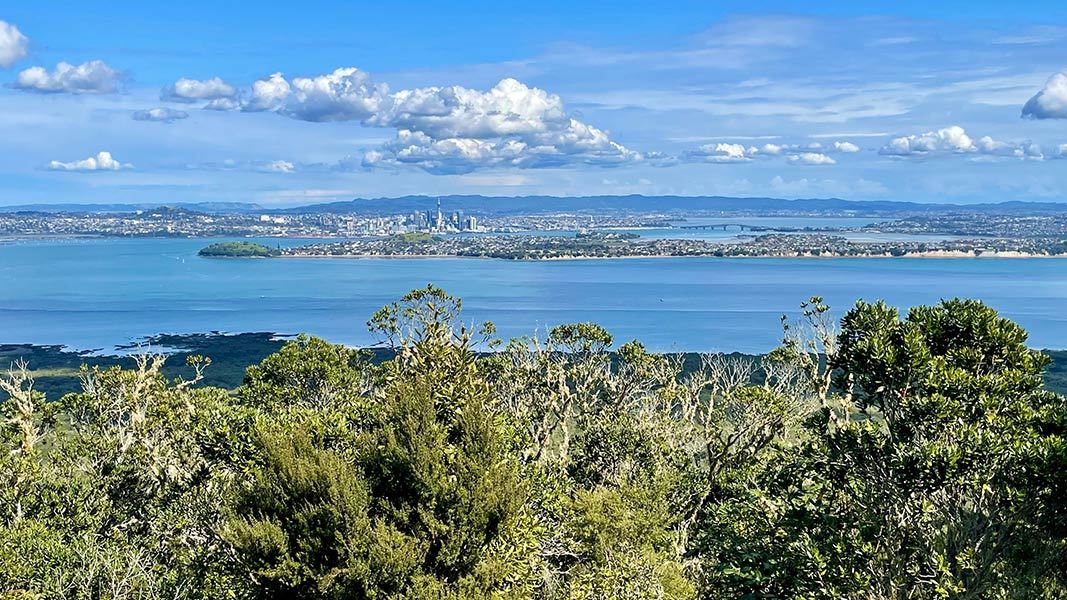- Well-formed paths through lava fields
- World's largest pōhutukawa forest
- Fitness required: Moderate fitness
- Gradient: Gradual incline
Image gallery
Video
Walk on well-formed paths through ancient lava fields that now support the largest pōhutukawa forest in the world and provide a home to dozens of shore, sea and forest birds.
At the summit another track circles the rim of the crater.
Side trip: Lava Caves Track
Time: 15 min one way from Summit Track; 1 hr one way from Rangitoto Wharf; 1 hr 45 min one way from Rangitoto Wharf to lava caves to summit
This short diversion off the Summit Track leads to lava tunnels and caves. If you want to explore the tunnels and caves, bring a torch. Return to the Summit Track or Summit Road via the sign posted track.
Alternative route: Wilson Park Track
Time: 1 hr 45 min from Rangitoto Wharf; 45 min from Summit Track turnoff to summit
This alternative route to the summit branches off the Summit Track before the Lava Caves Track turnoff.
Sections of this track are over broken lava fields - it is rough and uneven underfoot. Good foot wear is essential.
Rangitoto Island summit walks begin at the Rangitoto Wharf, a 25-minute ferry ride from Queens Wharf.
Alternatively, it's a 2-hour kayak to the wharf from Devonport or Takapuna Beach.
What to expect
- Track surface: Rough and uneven ground – the track crosses lava fields
- Elevation change: +/- 217 m
Hazards
- Rapidly changing weather conditions.
Amenities
- There are no rubbish bins on the island – take your rubbish back with you.
Be prepared
Ensure you take:
- food and drinking water – there is none available on the island
- good sturdy footwear.
Rangitoto emerged from the sea approximately 600 years ago in a series of fiery volcanic explosions. It is the youngest volcano in Auckland/Tāmaki Makaurau and sits right next to the oldest island, Motutapu, which is estimated to be more than 160 million years old.
Thanks to the world’s largest on-island pest-eradication programme, in 2011 Rangitoto was declared pest-free of the seven mammalian pests that had caused damage to the plants, trees and native animals.
Its pest-free status has seen native forest birds such as bellbird/korimako, New Zealand pigeon/kererū, tūī, fantail/pīwakawaka, grey warbler/riroriro, whitehead/pōpokotea and New Zealand parakeet/kākāriki flock back to survive and thrive.
The Hauraki Gulf is a global seabird hotspot with 27 species calling it home. Many visit the pest-free haven of Rangitoto along with shore birds such as New Zealand dotterel/tūturiwhatu and variable oystercatcher/tōrea.
Rangitoto baches
Around 30 classic holiday homes remain today, largely unchanged since the 1930s. Bach 38, adjacent to the Rangitoto Wharf, has been restored and turned into a museum run by volunteers from the Rangitoto Island Historic Conservation Trust. The museum is open on some weekends and by appointment - email info@rangitoto.org.
The Rangitoto bach settlements are irreplaceable artefacts of New Zealand's architectural and social history and therefore are of national significance.
Check you are pest-free
Check, clean, and seal your gear to ensure you don't bring pests, soil, and seeds.
Auckland information
| Phone: | +64 7 867 9080 |
| Email: | kauaerangavc@doc.govt.nz |
| About: | Kauaeranga Visitor Centre provides visitor information for this area |
